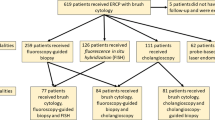Abstract
Objectives
To evaluate percutaneous brush cytology, forceps biopsy and a tandem procedure consisting of both, in the diagnosis of malignant biliary obstruction.
Methods
A retrospective review of consecutive patients who underwent biliary brush cytology and/or forceps biopsy between 01/2010 and 09/2014 was performed. The cytology and pathology results were compared to the composite outcome (including radiological, pathological and clinical data). Cost for tandem procedure compared to brush cytology and forceps biopsy alone was calculated.
Results
A total of 232 interventions in 129 patients (70.8 ± 11.0 years) were included. Composite outcome showed malignancy in 94/129 (72.9%) patients. Sensitivity for brush cytology, forceps biopsy and tandem procedure was 40.6% (95% CI 32.6–48.7%), 42.7% (32.4–53.0%) and 55.8% (44.7–66.9%) with 100% specificity, respectively. There were 9/43 (20.9%) additional cancers diagnosed when forceps biopsy was performed in addition to brush cytology, while there were 13/43 (30.2%) more cancers diagnosed when brush cytology was performed in addition to forceps biopsy. Additional costs per additionally diagnosed malignancy if tandem approach is to be utilised in all cases was $704.96.
Conclusion
Using brush cytology and forceps biopsy in tandem improves sensitivity compared to brush cytology and forceps biopsy alone in the diagnosis of malignant biliary obstruction.
Key points
• Tandem procedure improves sensitivity compared to brush cytology and forceps biopsy.
• Brush cytology may help to overcome “crush artefacts” from forceps biopsy.
• The cost per diagnosed malignancy may warrant tandem procedure in all patients.



Similar content being viewed by others
Abbreviations
- PTBD:
-
Percutaneous Transhepatic Biliary Drainage
- IR:
-
Interventional Radiology
- HJ:
-
Hepaticojenunal
References
Pereiras RV, Rheingold OJ, Huston D et al (1978) Relief of malignant obstructive jaundice by percutaneous insertion of a permanent prosthesis in the biliary tree. Ann Intern Med 89:583–589
Mori K, Misumi A, Sugiyama M, Okabe M, Matsuoka T (1977) Percutaneous transhepatic bile drainage. Ann Surg 185:111–115
Elyaderani MK, Gabriele OF (1980) Brush and forceps biopsy of biliary ducts via percutaneous transhepatic catheterization. Radiology 135:777–778
Rossi M, Cantisani V, Salvatori FM et al (2004) Histologic assessment of biliary obstruction with different percutaneous endoluminal techniques. BMC Med Imaging 4:3
Savader SJ, Prescott CA, Lund GB, Osterman FA (1996) Intraductal biliary biopsy: comparison of three techniques. J Vasc Interv Radiol JVIR 7:743–750
Tapping CR, Byass OR, Cast JEI (2012) Cytological sampling versus forceps biopsy during percutaneous transhepatic biliary drainage and analysis of factors predicting success. Cardiovasc Intervent Radiol 35:883–889
Rossi M, Lemos A, Bonaiuti P et al (1997) Instrumental diagnosis of obstructive jaundice: brushing versus biopsy. Radiol Med (Torino) 93:230–235
Jung G-S, Huh J-D, Lee SU, Han BH, Chang H-K, Cho YD (2002) Bile duct: analysis of percutaneous transluminal forceps biopsy in 130 patients suspected of having malignant biliary obstruction. Radiology 224:725–730
Li T-F, Ren K-W, Han X-W et al (2014) Percutaneous transhepatic cholangiobiopsy to determine the pathological cause of anastomotic stenosis after cholangiojejunostomy for malignant obstructive jaundice. Clin Radiol 69:13–17
Kitajima Y, Ohara H, Nakazawa T et al (2007) Usefulness of transpapillary bile duct brushing cytology and forceps biopsy for improved diagnosis in patients with biliary strictures. J Gastroenterol Hepatol 22:1615–1620
Owens D (1998) Interpretation of cost-effectiveness analyses. J Gen Intern Med 13:716–717
Bland JM, Butland BK. Comparing proportions in overlapping samples. https://www-users.york.ac.uk/~mb55/overlap.pdf. Accessed 1 Jan 2017
Landis JR, Koch GG (1977) The measurement of observer agreement for categorical data. Biometrics 33:159–174
Xing G-S, Geng J-C, Han X-W, Dai J-H, Wu C-Y (2005) Endobiliary brush cytology during percutaneous transhepatic cholangiodrainage in patients with obstructive jaundice. Hepatobiliary Pancreat Dis Int HBPD INT 4:98–103
Yamagami T, Iida S, Kato T, Tanaka O, Nishimura T (2003) Combining fine-needle aspiration and core biopsy under CT fluoroscopy guidance: a better way to treat patients with lung nodules? Am J Roentgenol 180:811–815
Kiranantawat N, Petranovic M, Digumarthy S et al (2015) Clinical role and accuracy of CT-guided percutaneous needle biopsy of cavitary pulmonary lesions. 29 November–4 December 2015, Chicago IL.; archive.rsna.org/2015/15047606.html. Accessed 31 Jan 2016
Li Z, Li T-F, Ren J-Z et al (2016) Value of percutaneous transhepatic cholangiobiopsy for pathologic diagnosis of obstructive jaundice: analysis of 826 cases. Acta Radiol 58:3–9
Song K, Toweill D, Rulyak SJ, Lee SD (2011) Novel jumbo biopsy forceps for surveillance of inflammatory bowel disease: a comparative retrospective assessment. Gastroenterol Res Pract 2011:671659
O’Neill CB, Atoria CL, O’Reilly EM, LaFemina J, Henman MC, Elkin EB (2012) Costs and trends in pancreatic cancer treatment. Cancer 118:5132–5139
Author information
Authors and Affiliations
Corresponding author
Ethics declarations
Guarantor
The scientific guarantor of this publication is Olga R. Brook.
Conflict of interest
The authors of this manuscript declare no relationships with any companies whose products or services may be related to the subject matter of the article.
Funding
The authors state that this work has not received any funding.
Statistics and biometry
One of the authors has significant statistical expertise (Alexander Brook).
Ethical approval
Institutional review board approval was obtained.
Informed consent
Written informed consent was waived by the institutional review board.
Study subjects or cohorts overlap
None of the study subjects or cohorts have been previously reported.
Methodology
• retrospective
• diagnostic or prognostic study
• performed at one institution
Electronic supplementary material
Below is the link to the electronic supplementary material.
Appendix Table 1
(DOCX 13 kb)
Appendix Table 2
(DOCX 13 kb)
Rights and permissions
About this article
Cite this article
Boos, J., Yoo, R.J., Steinkeler, J. et al. Fluoroscopic percutaneous brush cytology, forceps biopsy and both in tandem for diagnosis of malignant biliary obstruction. Eur Radiol 28, 522–529 (2018). https://doi.org/10.1007/s00330-017-4987-5
Received:
Revised:
Accepted:
Published:
Issue Date:
DOI: https://doi.org/10.1007/s00330-017-4987-5




